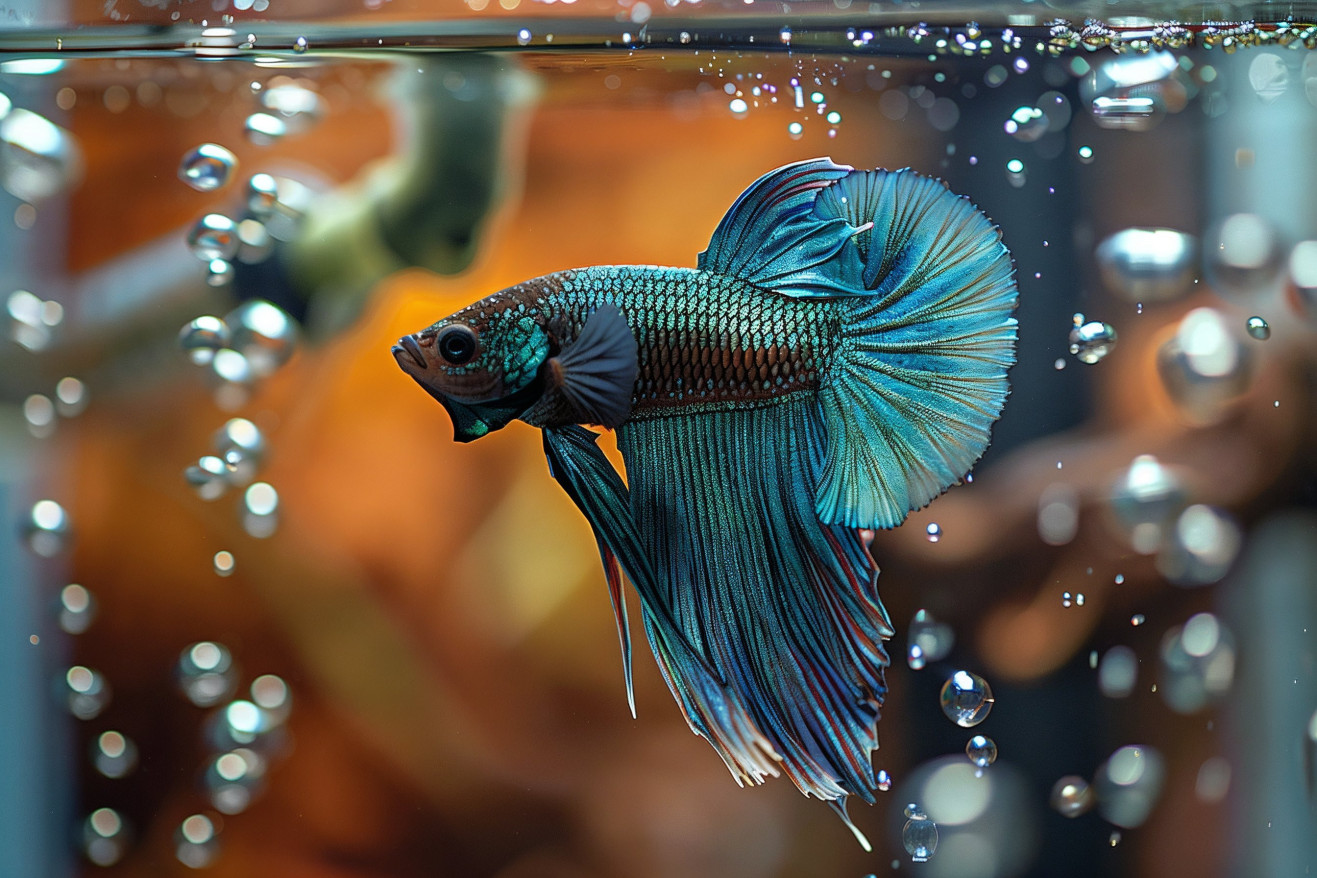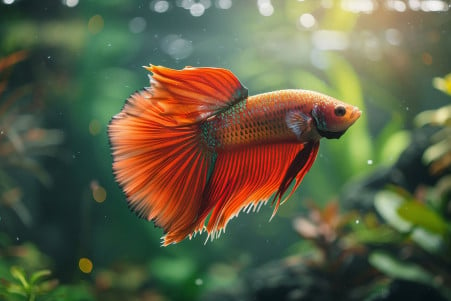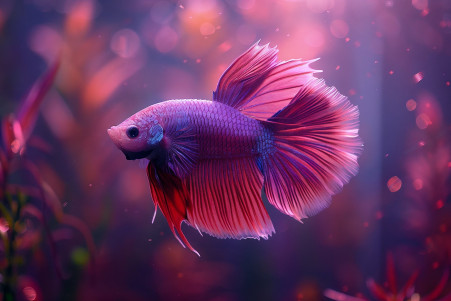Air Stone vs. Air Pump: What's Best for Your Betta Tank?
11 June 2024 • Updated 11 June 2024

While bettas are labyrinth fish that can breathe air at the water's surface, it's still a good idea to add an air stone or other form of aeration to their tank. This is because while bettas can survive in low-oxygen conditions by breathing at the surface, they will be healthier and happier if the oxygen levels in their tank are higher. An air stone or air pump is the best way to ensure that the water in your betta's tank is properly oxygenated, especially if you have a small tank.
This article will explore the science and expert opinions behind the best ways to care for betta fish, including in-depth research into how bettas breathe and how much oxygen they need. By learning about the biological needs of bettas and the best ways to set up their tanks, you can make sure that you are providing the right level of aeration and the best possible environment for your betta to thrive.
Do betta fish need a bubbler?
The Labyrinth Organ
Bettas, or Siamese fighting fish, have a special biological adaptation that allows them to breathe air from the surface of the water. This adaptation is made possible by the labyrinth organ, a primitive lung-like organ that serves as an accessory respiratory organ.
As Kuuloakai explains, the labyrinth organ makes it possible for bettas to live in low-oxygen environments that would be deadly to most other fish. By taking in air from the surface, bettas can take in oxygen from the air, which they then use to supplement the oxygen they take in through their gills.
That said, it's important to note that even though bettas can breathe air, they still need dissolved oxygen in the water to support their gills. As BettaFishBay points out, it's important to ensure that the water in the betta's tank has an oxygen level of 5-7 parts per million (ppm) to ensure the fish's health and well-being.
By learning about the labyrinth organ and how it works to support air breathing, fish keepers can make sure they're meeting the specific oxygen needs of their betta fish. This is important because it will help them create an environment that supports the fish's special respiratory needs while also ensuring that there's enough dissolved oxygen to support the fish's gills.
Things That Impact the Need for Aeration
The size of the betta tank is one of the most important factors that will determine whether or not you need to add aeration. Smaller tanks may require a bubbler or air pump to help ensure that oxygen levels stay high enough due to the smaller surface area for gas exchange, according to Bettaboxx. The number of fish in the tank and their bioload will also impact the need for oxygen, according to Kuuloakai.
Water parameters, such as temperature and pH, can also impact the solubility of oxygen and the amount of oxygen available to the betta. As BettaFishBay points out, it's important to make sure that oxygen levels stay between 5-7 ppm for the health of your betta. However, live plants, a good filter, and regular water changes can help ensure that the water is oxygenated, which may mean that you won't need to add a bubbler.
On the other hand, there are some medications or treatments that can decrease the oxygen levels in the water, which may mean that you need to add aeration for a short period of time, as the study noted. Knowing about these different factors can help you determine whether or not you need to add a bubbler or air pump to your tank to make sure that your betta has the best environment possible.
Pros and Cons of Using a Bubbler
The use of a bubbler or air pump in a betta tank has both pros and cons that you should weigh before deciding to add one to your tank. According to Bettaboxx, a bubbler can help with water circulation and oxygenation, which can help with gas exchange and potentially reduce stress for the betta. However, Kuuloakai points out that the extra equipment and maintenance, as well as the increase in electricity, are cons.
BettaFishBay suggests that if you’re going to use an air pump, you should use a gentle air stone or sponge filter instead of a strong air pump, which can cause too much surface agitation and stress the betta. It’s important to make sure that the air stone or sponge filter is positioned and adjusted so that it doesn’t cause too much surface agitation. On the other hand, Bettaboxx says that live plants, regular water changes, and high-quality filters can help keep the water in your betta tank clean and oxygenated without the need for a bubbler.
How to Set Up a Betta Tank to Avoid Needing an Air Pump
Of course, the best way to avoid needing an air pump is to set up your betta tank in a way that doesn't require one. This means ensuring that your betta has everything it needs to thrive without the addition of a bubbler or air stone.
One of the most important aspects of a betta tank is the size. While many people may keep their bettas in small bowls or tanks, the reality is that bettas need at least 2.5 gallons to be healthy. That said, Bettafish.org recommends a 5-gallon tank or larger for a single betta. In addition to the size of the tank, it's also important to make sure that the tank has a gentle filter or sponge filter, as bettas don't like a lot of water movement.
In terms of water temperature, bettas need to be kept in water that's between 76-82°F (24-28°C). This can be achieved with an adjustable heater, as PetMD explains. Finally, to help your betta feel safe and secure, make sure to include live plants and hiding spots in the tank.
In addition to these factors, you'll also need to perform regular water changes and gravel vacuuming to keep the tank clean and the water quality high. According to Petco, you should do a 10-25% water change every two to four weeks. This will help ensure that the water quality is good and that you don't need to add an air pump to the tank.
Overall, by setting up your tank in a way that meets all of your betta's needs and keeps the water clean, you can avoid needing an air pump.
Monitoring and Maintaining Optimal Water Quality
Optimal water quality is essential to the health and well-being of betta fish. Bettaboxx advises that water parameters should be checked regularly and that the goal should be 0 ammonia, 0 nitrites, and nitrates below 20 parts per million (ppm). Partial water changes of 25-50% should be done weekly to remove nitrates and add in fresh, oxygenated water.
It’s also important to vacuum the gravel during water changes to remove waste and uneaten food that can lead to a decrease in water quality over time, according to the Betta Fish Forum. It’s also important to maintain a well-cycled tank that allows for the growth of beneficial bacteria that will help convert harmful ammonia and nitrites into less harmful nitrates.
If ammonia or nitrite levels spike, especially during the cycling process, Betta Splendid recommends using water conditioners or additives that will help to detoxify these compounds and keep the betta safe. By keeping a close eye on water parameters and taking steps to ensure optimal water quality, fish owners can ensure that their betta fish live in a healthy, happy environment.
Conclusion: Finding the Right Balance Between Betta Requirements and Tank Conditions
While bettas can survive in still water, some aeration and water movement are important for their overall health. Hepper explains that a bubbler can help with water circulation and oxygenation, which in turn helps with gas exchange and can help the fish feel less stressed.
That said, the need for a bubbler depends on a variety of factors including tank size, stocking density, water parameters, and decor. Bettaboxx points out that smaller tanks may require aeration to keep oxygen levels up, while Kuuloakai explains that the number of fish in a tank and their bioload will dictate how much oxygen they need.
That said, proper tank setup, maintenance, and water quality are all important for ensuring that bettas are living in the best possible conditions. PetMD suggests a minimum tank size of 2.5 gallons, with 5 gallons or more being better, and a water temperature between 76-82°F (24-28°C).
It's important to remember that each betta is an individual, and their needs may vary. By understanding the factors that play into the need for aeration and making sure that tanks are set up to meet those needs, fish owners can ensure that their bettas are living in the best possible conditions.


